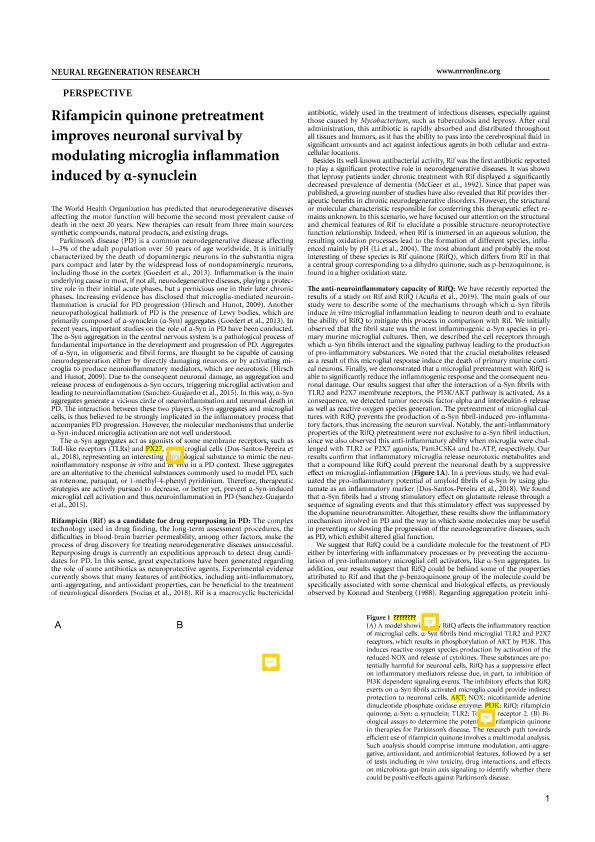Artículo
Rifampicin quinone pretreatment improves neuronal survival by modulating microglia inflammation induced by α-synuclein
Fecha de publicación:
12/2019
Editorial:
Shenyang Editorial Dept Neural Regeneration Res
Revista:
Neural Regeneration Research
ISSN:
1673-5374
Idioma:
Inglés
Tipo de recurso:
Artículo publicado
Clasificación temática:
Resumen
The World Health Organization has predicted that neurodegenerative diseasesaffecting the motor function will become the second most prevalent cause ofdeath in the next 20 years. New therapies can result from three main sources:synthetic compounds, natural products, and existing drugs. Parkinson?s disease (PD) is a common neurodegenerative disease affecting 1?3% of the adult population over 50 years of age worldwide. It is initially characterized by the death of dopaminergic neurons in the substantia nigra pars compact and later by the widespread loss of nondopaminergic neurons, including those in the cortex (Goedert et al., 2013). Inflammation is the main underlying cause in most, if not all, neurodegenerative diseases, playing a protective role in their initial acute phases, but a pernicious one in their later chronic phases. Increasing evidence has disclosed that microglia-mediated neuroinflammation is crucial for PD progression (Hirsch and Hunot, 2009). Another neuropathological hallmark of PD is the presence of Lewy bodies, which are primarily composed of α-synuclein (α-Syn) aggregates (Goedert et al., 2013). In recent years, important studies on the role of α-Syn in PD have been conducted. The α-Syn aggregation in the central nervous system is a pathological process of fundamental importance in the development and progression of PD. Aggregates of α-Syn, in oligomeric and fibril forms, are thought to be capable of causing neurodegeneration either by directly damaging neurons or by activating microglia to produce neuroinflammatory mediators, which are neurotoxic (Hirsch and Hunot, 2009). Due to the consequent neuronal damage, an aggregation and release process of endogenous α-Syn occurs, triggering microglial activation and leading to neuroinflammation (Sanchez-Guajardo et al., 2015). In this way, α-Syn aggregates generate a vicious circle of neuroinflammation and neuronal death in PD. The interaction between these two players, α-Syn aggregates and microglial cells, is thus believed to be strongly implicated in the inflammatory process that accompanies PD progression. However, the molecular mechanisms that underlie α-Syn-induced microglia activation are not well understood.
Palabras clave:
Inflammation
,
Drug repurposing
,
Rifampicin quinone
Archivos asociados
Licencia
Identificadores
Colecciones
Articulos(IPE)
Articulos de INST.DE PATOLOGIA EXPERIMENTAL
Articulos de INST.DE PATOLOGIA EXPERIMENTAL
Citación
Acuña, Leonardo; Corbalan, Natalia Soledad; Raisman Vozari, Rita; Rifampicin quinone pretreatment improves neuronal survival by modulating microglia inflammation induced by α-synuclein; Shenyang Editorial Dept Neural Regeneration Res; Neural Regeneration Research; 15; 8; 12-2019; 1473-1474
Compartir
Altmétricas




